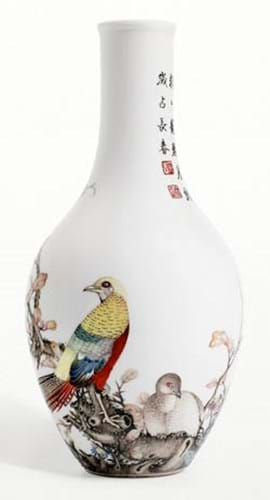
The 11 classical, modern and contemporary Chinese art, watches, wine and jewellery auctions held from April 1 to 8 posted a premium-inclusive HK$3.49bn (£274.8m) - a 13 per cent rise on their record-breaking series last October. Chinese ceramics and works of art was the highest grossing category, with four sales contributing more than a third of the overall total.
However, the series was not plain sailing. Mainland Chinese buyers are the lifeblood of this highly lucrative market, but late payments have become a thorny issue for auction houses the world over.
In this series, Sotheby's took a tougher stance on late payers, barring a number of major buyers with poor track records. In this they followed the lead set by Toulouse auction houses when selling two important Qianlong works of art in March (reported here).
At the risk of slowing down the market, big deposits and contractual obligations to settle quickly are expected to become the norm at major sales in London and New York.
So while Sotheby's specialist Nicolas Chow can be confident payments will be recovered promptly for this series, the absence of a few key players coupled with what some dealers felt were 'final price' estimates, took the fizz out of the highest profile outing of the series: a selection of 77 ceramics from the Meiyintang collection of Imperial Chinese porcelain.
The April 7 sale made just half its low estimate at a premium-inclusive HK$399.4m (£31.4m) and take-up by lot was 70 per cent. Buying at auction is an intensely psychological game and the mood at any sale is critical: here Mr Chow felt confidence was lost in the room after the collection's early highlight, the Imperial Qianlong (1736-95) falangcai (foreign colour) golden pheasant vase failed to sell.
Nevertheless, there were post-sale deals to be done. The vase did sell immediately after the sale for its HK$180m (£14.2m) low estimate to a buyer from outside of mainland China. A second high-profile casualty, a Chenghua (1465-87) mark and period palace bowl, was also secured by a non-mainland Chinese buyer within 20 minutes of the sale's closure for its low estimate at HK$80m (£6.3m).
During the sale, London and New York's Littleton and Hennessy secured the most expensive ceramic, a Xuande (1426-35) blue and white brush washer, at HK$45m (£3.5m). They had come prepared to bid more.
The Meiyintang collection (the name translates as Hall among Rose Beds) is widely acknowledged to belong to wealthy Swiss nonagenarian Stephen Zuellig. He assembled this exclusive holding over half a century together with his late brother Gilbert, who focused on earlier works from the Neolithic to the 13th century. A further tranche from this published holding is expected.
There was more of a buzz and bidding was more spirited for what the trade felt was a more attractively estimated group of material in the 337-lot, mixed-vendor outing the following day. It fetched a premium-inclusive HK$583m (£45.9m) while the HK$125.4m (£9.9m) single-owner sale of 26 rhinoceros horn carvings from the Edward and Franklin Chow collection fielded just one casualty.
Outside of this collecting field, various in-house records tumbled, with white glove auctions of wine and contemporary Chinese art, including the celebrated 105-lot Ullens holdings which fetched HK$427.2m (£33.6m) including premium.
The collection included important early works from the 1980s to early 1990s by established artists and was headlined by Zhang Xiaogang's HK$70m (£5.5m) triptych Forever Lasting Love - an all-time high for the artist and well in excess of the previous HK$52.2m record.
The triptych featured in Beijing's seminal 1989 National Art Gallery exhibition China Avant-Garde, after which it was split between two collectors and later reunited by Baron Ullens, the Belgian founder of Beijing's largest private art museum, the Ullens Centre for Contemporary Art.
The lion's share of the collection sold to Asian buyers, although American and European collectors took home a quarter of the works of art.
The success of the Ullens collection is the latest signal that the contemporary Chinese art market has bounced back following the downturn in 2008, although buyers remain selective, focusing on early significant works with provenance.
£1 = HK$12.7
By Kate Hunt




